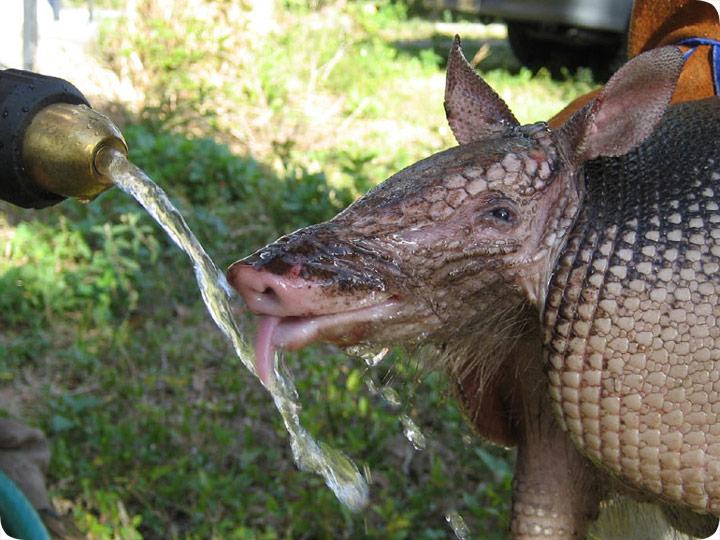-
info@aaanimalcontrol.com
Call us for help in your town
Humane Wildlife Education
Animal Hydration - Thirsty Armadillo

03.23.2007 - Now here's a thirsty critter! This is a Nine-Banded Armadillo, after a day of being stuck in a trap. I usually work very hard to keep the animals cool. I set traps in the shade, I cover traps when I can, and I always retrieve the animals as early as possible.
The worst thing to do is to leave an animal in a cage all day, particularly out in the sun and without water! That is a very inhumane thing to do, and it causes the animal to suffer, and perhaps suffer heat stroke or death. It's important to get the animal removed and relocated
quickly. In a case in which I believe an animal is thirsty, I give it water. In the case of a thirsty American Alligator, I give it Gatorade. I didn't want this armadillo to have to search for water for a long time, so I simply held it, and got out the garden hose, and gave the
animal a drink. I've given raccoons, squirrels, opossums, and all manner of critters water from the hose or a bottle. If they're thirsty, they'll drink it up.
I was most pleased with this armadillo as it happily lapped up the water.
It looked so refreshed and satisfied on a hot Florida spring afternoon. It's making me want a glass of water right now! I'm going to go get one.
Do it yourself: Visit my How To Get Rid of Armadillos page for tips and advice.
Get professional help: Visit my Nationwide Pro Directory of wildlife removal experts.
Armadillos as food? I would never eat one, as I care for these cool animals. On the other hand, armadillos like to eat but they can also be eaten by people. Oddly enough, armadillo is commonly feasted upon in areas of southern North America. Unlike raw beef or chicken, undercooked armadillo carries with it the chance of catching leprosy, a serious disease that causes skin lesions. Aside from us eating armadillos, these creatures will eat their fair share of grubs and worms, which is why they are often unwanted visitors in a garden or yard. The armadillo will create a burrow system in less than a night, and this ability is what keeps it stocked with the small critters it loves to eat. Because most of what an armadillo eats is dug out of the ground, they are very hard to catch with bait. It is not natural for one of these animals to eat dead worms out of a sock (a common suggestion for trap baiting). The most reliable way to trap an armadillo is by placing the cage trap directly in front of the burrow. The creature has poor eyesight and will rely on the same pathways for travel. Placing the trap in the creature's way will be a surprisingly easy way to catch it.
For more wildlife stories, click my Wildlife Blog
or click my below banner to hire a local trapper.
Just like any other animal, the armadillo can suffer dehydration when not effectively and humanely handled. Even though it's a messy and nocturnal critter, it deserves a humane handling right from the time it's trapped to the time of relocation. This includes protecting the animal from the far-reaching effects of dehydration caused by long-hours of the sun's heating while stuck in a trap. In most cases, you can avoid animal dehydration in the following ways.
Hiding the trap from direct sunlight.
Putting a shade over the trap whenever you cannot hide it.
Inspecting the traps regularly to ensure that the trapped animal does not suffer heat stress for long as it may lead to heatstroke.
When you cannot avoid setting the trap in the sun, always check for the trapped animal at a close interval and provide drinking water for the animal using a bottle or garden hose when you suspect it's thirsty.
Trapping and removal of an armadillo is the most effective way of controlling this messy critter as it burrows underground and removes heaps of soil and trash outside their tunnels to create ‘highways' for themselves. Since armadillos dig deep in the ground to get worms for themselves, using a baited trap to get rid of them isn't practical. At the same time, there's no single repellant that keeps this ugly fellow at bay. As such, you should locate its path and place your trap right on it. This method has a higher success rate since armadillos have poor vision and always move through previous tracks.
Even though this creature might not seem like a big nuisance, getting rid of it as soon as possible is important. Armadillos can cause massive destruction under the house by removing the soil under your deck and floor, leading to down-warping. And the situation could be even worse if your property is infested with more than one armadillo.
Additionally, armadillos give birth to four young ones. Therefore, leaving it to stay in your home for a bit longer could create more problems. If an armadillo infests your home and you have no idea of what to do, you should contact a professional wildlife remover to help you with your armadillo problem. They will be able to properly and efficiently trap and relocate the critter. And if you have the skills needed to do the job, then you can give it a try too.




















